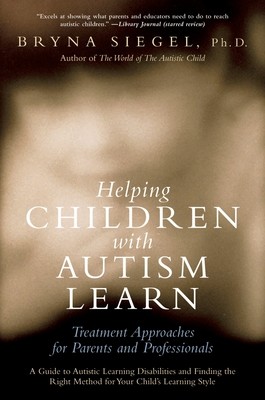
- We will send in 10–14 business days.
- Author: Bryna Siegel
- Publisher: Oxford University Press, USA
- ISBN-10: 0195325060
- ISBN-13: 9780195325065
- Format: 15.6 x 23.5 x 3.3 cm, softcover
- Language: English
- SAVE -10% with code: EXTRA
Reviews
Description
Bryna Siegel gives parents of autistic children what they need most: hope. Her first book, The World of the Autistic Child, became an instant classic, illuminating the inaccessible minds of afflicted children. Now she offers an equally insightful, thoroughly practical guide to treating the learning disabilities associated with this heartbreaking disorder.
The trouble with treating autism, Siegel writes, is that it is a spectrum disorder--a combination of a number of symptoms and causes. To one extent or another, it robs the child of social bonds, language, and intimacy--but the extent varies dramatically in each case. The key is to understand each case of autism as a discrete set of learning disabilities, each of which must be treated individually. Siegel explains how to take an inventory of a child's particular disabilities, breaks down the various kinds unique to autism, discusses our current knowledge about each, and reviews the existing strategies for treating them. There is no simple cure for this multifarious disorder, she writes; instead, an individual program, with a unique array of specific treatments, must be constructed for each child. She gives practical guidance for fashioning such a program, empowering parents to take the lead in their child's treatment. At the same time, she cautions against the proliferating, butquestionable, treatments hawked to afflicted families. She knows the panic to do something, anything, to help an autistic child, and she offers parents reassurance and support as well as sensible advice, combining knowledge from experience, theory and research. For parents, autism in a child is heartbreaking. But it need not be overwhelming. Bryna Siegel offers a new understanding, and a practical, thoughtful approach that will give parents new hope.
EXTRA 10 % discount with code: EXTRA
The promotion ends in 19d.20:48:00
The discount code is valid when purchasing from 10 €. Discounts do not stack.
- Author: Bryna Siegel
- Publisher: Oxford University Press, USA
- ISBN-10: 0195325060
- ISBN-13: 9780195325065
- Format: 15.6 x 23.5 x 3.3 cm, softcover
- Language: English English
Bryna Siegel gives parents of autistic children what they need most: hope. Her first book, The World of the Autistic Child, became an instant classic, illuminating the inaccessible minds of afflicted children. Now she offers an equally insightful, thoroughly practical guide to treating the learning disabilities associated with this heartbreaking disorder.
The trouble with treating autism, Siegel writes, is that it is a spectrum disorder--a combination of a number of symptoms and causes. To one extent or another, it robs the child of social bonds, language, and intimacy--but the extent varies dramatically in each case. The key is to understand each case of autism as a discrete set of learning disabilities, each of which must be treated individually. Siegel explains how to take an inventory of a child's particular disabilities, breaks down the various kinds unique to autism, discusses our current knowledge about each, and reviews the existing strategies for treating them. There is no simple cure for this multifarious disorder, she writes; instead, an individual program, with a unique array of specific treatments, must be constructed for each child. She gives practical guidance for fashioning such a program, empowering parents to take the lead in their child's treatment. At the same time, she cautions against the proliferating, butquestionable, treatments hawked to afflicted families. She knows the panic to do something, anything, to help an autistic child, and she offers parents reassurance and support as well as sensible advice, combining knowledge from experience, theory and research. For parents, autism in a child is heartbreaking. But it need not be overwhelming. Bryna Siegel offers a new understanding, and a practical, thoughtful approach that will give parents new hope.


Reviews